Aerial Filming...

...Now Becoming a Norm in India
History was made on October 30, 2011, as India hosted its very first Formula One World Championship. Tens of thousands of locals and tourists flocked to the newly constructed Buddh International Circuit in Greater Noida, outskirts of Delhi, to catch the excitement of the world’s most famous car race; while many more millions watched the action unfold on TV around the world.
On October 28, 2012, top teams from all over the world will burn the rubbers and “wroom” to mark the “2012 Grand Prix Open”.
This year Eurocopter AS350 B3 of Pinnacle air was flying above the circuit covering the race with aerial shots that mesmerized and captivated the TV audience. As demonstrated at this widely televised world sporting event, aerial filming certainly helped to enhance the overall viewing experience.
Large-scale sporting events such as the New York and Paris Marathons and Tour de France have been using helicopters for aerial filming for many years now. Both the Indian Grand Prix (2011 and 2012) and the 2010 Commonwealth Games saw the deployment of helicopters—viewers were treated to an amazing bird’s-eye view of the action, as it happened.
Aerial filming has become a “staple” in Hollywood movie-making, and it is evident that Bollywood directors have also taken a liking to the use of helicopters for those spectacular aerial shots that give movies the extra dimension. And for the newsmaker or documentary director, helicopters have become an almost indispensable tool for the sensational breaking news or breathtaking aerial views.
In this day and age where the public expects “live” coverage and breaking news at their fingertips and films with high standard of cinematography, what the helicopter does in producing such results, has been treated as a “given”. Aerial filming can indeed become a “given”, as the advanced technology of helicopters and state-of-the-art equipment available today have made aerial filming not only safe and cost-efficient, but are also capable of producing high-quality and stable images.
The benefits of aerial filming have been most evident in the widespread use of helicopters for electronic news gathering (ENG) services. High-tech heliborne ENG services have become an essential source for today’s leading news agencies and reporting departments the world over for source video, live news coverage, broadcast quality documentation and breaking news situations.
For example, when a natural disaster strikes, viewers have seen how fast the international news channels and agencies have been able to produce breaking news not only through local correspondents’ reports, but also through aerial views of the location to supplement the viewers’ understanding and awareness of the situation.
News agencies in developed markets like the US, Europe and the Far East have been using aerial footage from helicopters for a long time. The use of helicopters for daily news coverage has provided these news agencies the crucial edge in today’s growing and competitive news gathering market. Even developing helicopter markets such as Brazil have seen an increase in the use of helicopters for such purposes, where aerial shots are great complements to video coverage on ground.
One of the most popular ENG helicopters in use today, is the Eurocopter AS350 from the “Ecureuil” family. This rotary-wing aircraft can be fitted with fully high definition, vibration free, gyromounted cameras to get crystal clear images without any disturbance, and has a competition-beating 3.5 hours of flight endurance while fully equipped. Besides offering its passengers a very comfortable ride, the cabin is also highly flexible to be altered for different needs as the situation demands, providing a convenient work environment for on-air live situations.





